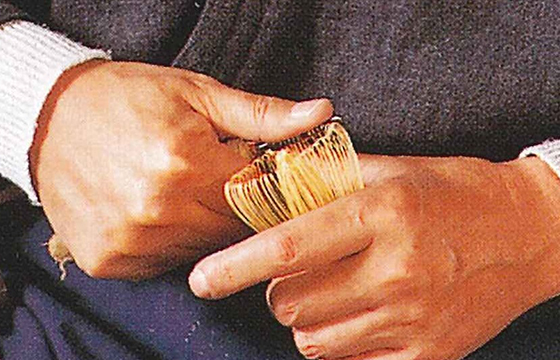
Takayama Chasen

A tea whisk begins as a piece of bamboo about 10 cm in length.
After the outer layer has been removed, the bamboo is split part ways into 16 sections, or 18 if it is especially fat.
The inside is then whittled away, and each section is further divided into 10 strands.
The whisk is then simmered in hot Water, and the inside is further whittled, with each strand tapering toward the tip, often no more than 0.
03 mm acroSS.
The most demanding step is curling the strands inward, giving the Whisk its characteristic bowed shape; this has a major impact on the taste of the tea.
The tip of each strand is then bent inward, and the strands are bound together at their base with thread.
KUBO Keizo Comes from a family of tea whisk makers stretching back 24 generations, almost to the Origins of the tea ceremony itself.
The tea whisk originated in Takayama in the Muromachi era (1333-1568), and the techniques for its manufacture have remained unchanged for hundreds of years.
After the outer layer has been removed, the bamboo is split part ways into 16 sections, or 18 if it is especially fat.
The inside is then whittled away, and each section is further divided into 10 strands.
The whisk is then simmered in hot Water, and the inside is further whittled, with each strand tapering toward the tip, often no more than 0.
03 mm acroSS.
The most demanding step is curling the strands inward, giving the Whisk its characteristic bowed shape; this has a major impact on the taste of the tea.
The tip of each strand is then bent inward, and the strands are bound together at their base with thread.
KUBO Keizo Comes from a family of tea whisk makers stretching back 24 generations, almost to the Origins of the tea ceremony itself.
The tea whisk originated in Takayama in the Muromachi era (1333-1568), and the techniques for its manufacture have remained unchanged for hundreds of years.
TM © Rugby World Cup Limited 2015. All rights reserved.
)
)